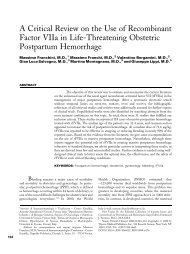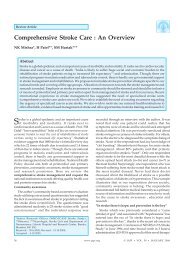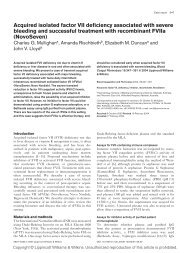Pathophysiology and management of dengue hemorrhagic fever
Pathophysiology and management of dengue hemorrhagic fever
Pathophysiology and management of dengue hemorrhagic fever
You also want an ePaper? Increase the reach of your titles
YUMPU automatically turns print PDFs into web optimized ePapers that Google loves.
6<br />
Platelet counts (/µL)<br />
CHUANSUMRIT & TANGNARARATCHAKIT<br />
120,000<br />
100,000<br />
80,000<br />
60,000<br />
40,000<br />
20,000<br />
0<br />
Day –2 Day –1 Day 0<br />
Day <strong>of</strong> iIlness<br />
Day +1 Day +2<br />
Figure 1. The platelet counts <strong>of</strong> children with <strong>dengue</strong><br />
<strong>hemorrhagic</strong> <strong>fever</strong> grades I ( n = 78) ( �),<br />
II ( n = 112) ( �),<br />
III (n = 40) (�) <strong>and</strong> IV (n = 16) (�). Day 0 is the day <strong>of</strong><br />
defervescence, Day −1 <strong>and</strong> Day −2 are 1 day <strong>and</strong> 2 days<br />
before defervescence, <strong>and</strong> Day +1 <strong>and</strong> Day +2 are 1 day<br />
<strong>and</strong> 2 days after defervescence.<br />
most prominent during the toxic stage. The mechanisms<br />
<strong>of</strong> thrombocytopenia include decreased platelet production<br />
<strong>and</strong> increased peripheral destruction. Na Nakorn<br />
et al. studied the bone marrow <strong>of</strong> patients with DHF<br />
during the acute febrile stage <strong>and</strong> found marked hypocellularity<br />
with a decrease in megakaryocytes, erythro-<br />
22<br />
blasts <strong>and</strong> myeloid precursors. The finding was later<br />
explained by the direct <strong>dengue</strong> virus infection <strong>of</strong><br />
23<br />
hematopoietic progenitor cells <strong>and</strong> stromal cells. Additionally,<br />
the increased peripheral destruction is markedly<br />
prominent during 2 days before defervescence. The<br />
bone marrow then revealed hypercellularity with an<br />
increase in the megakaryocyte, erythroblast <strong>and</strong> myeloid<br />
precursors. Hemophagocytosis <strong>of</strong> young <strong>and</strong><br />
mature erythroid <strong>and</strong> myeloid cells, lymphocytes <strong>and</strong><br />
22<br />
platelets was observed. Survival <strong>of</strong> patients’ <strong>and</strong><br />
24,25<br />
transfused platelets was markedly decreased because<br />
26<br />
<strong>of</strong> immune-mediated injury <strong>of</strong> platelets. In 1987<br />
27<br />
Funahara et al. demonstrated interaction in vitro<br />
between platelets <strong>and</strong> <strong>dengue</strong> virus-infected endothelial<br />
cells inducing platelet aggregation <strong>and</strong> subsequent lysis<br />
that resulted in thrombocytopenia. Subsequently, the<br />
number <strong>of</strong> platelets is rapidly increased in the convalescent<br />
stage <strong>and</strong> reaches the normal level within 7–10<br />
days after the defervescence.<br />
Platelet dysfunction as evidenced by the absence <strong>of</strong><br />
adenosine diphosphate (ADP) release was initially demonstrated<br />
in patients with DHF during the convalescent<br />
24<br />
stage by Mitrakul et al. in 1977. The subsequent<br />
| MANAGEMENT OF DENGUE HEMORRHAGIC FEVER<br />
study during the febrile <strong>and</strong> early convalescent stages<br />
28<br />
by Srichaikul et al. in 1989 also demonstrated the<br />
impaired platelet aggregation response to ADP that<br />
returned to a normal response 2–3 weeks later. An<br />
increase in plasma β-thromboglobulin<br />
<strong>and</strong> platelet factor<br />
4, indicating increased platelet secretory activity,<br />
28<br />
was observed. The platelet dysfunction might be the<br />
result <strong>of</strong> exhaustion from platelet activation triggered<br />
26<br />
by immune complexes containing <strong>dengue</strong> antigen.<br />
Coagulopathy<br />
During the acute febrile stage, mild prolongation <strong>of</strong> the<br />
prothrombin time <strong>and</strong> partial thromboplastin time, as<br />
well as reduced fibrinogen levels, have been demon-<br />
24,29<br />
strated in several studies. Variable reductions in the<br />
activities <strong>of</strong> several coagulation factors, including prothrombin,<br />
factors V, VII, VIII, IX <strong>and</strong> X, antithrombin<br />
<strong>and</strong> α2-antiplasmin,<br />
have been demonstrated. Fibrin<br />
11<br />
degradation product or D-dimer is slightly elevated. In<br />
2002 Wills et al. reported the coagulation abnormalities<br />
in 167 Vietnamese children with <strong>dengue</strong> shock<br />
30<br />
syndrome. Low levels <strong>of</strong> anticoagulant proteins C <strong>and</strong><br />
S <strong>and</strong> antithrombin III were found to be associated with<br />
increasing severity <strong>of</strong> shock, presumably due to plasma<br />
leakage. Elevated levels <strong>of</strong> tissue factor, thrombomodulin<br />
<strong>and</strong> plasminogen activator inhibitor-1 reflect endothelial,<br />
platelet <strong>and</strong>/or monocyte activation <strong>and</strong> may be<br />
a secondary response to direct activation <strong>of</strong> fibrinolysis<br />
by the <strong>dengue</strong> virus. The coagulation abnormality is<br />
well compensated for in the majority <strong>of</strong> patients without<br />
circulatory collapse.<br />
Most <strong>of</strong> the patients have serum aspartate transaminase<br />
(AST) <strong>and</strong> alanine transaminase (ALT) levels three<strong>and</strong><br />
tw<strong>of</strong>old higher than normal, respectively. There is<br />
focal necrosis <strong>of</strong> hepatic cells, swelling appearance <strong>of</strong><br />
Councilman bodies <strong>and</strong> hyaline necrosis <strong>of</strong> Kupffer<br />
cells. Proliferation <strong>of</strong> mononuclear leucocytes <strong>and</strong> less<br />
frequently polymorphonuclear leucocytes occurs in the<br />
sinusoids <strong>and</strong> occasionally in the portal areas.<br />
HIGH-RISK PATIENTS<br />
Because <strong>of</strong> progress in comprehensive care techniques,<br />
the mortality rate among patients with DHF in Thail<strong>and</strong><br />
has progressively declined from 13.7% in 1958 to 0.17%<br />
in 2001. However, the mortality rate has remained<br />
unchanged up to the year 2004. Nevertheless, high-risk<br />
patients are prone to serious complications resulting in<br />
© 2006 The Authors<br />
Journal Compilation © 2006 LMS Group • Transfusion Alternatives in Transfusion Medicine 8 (Suppl. 1), 3–11





